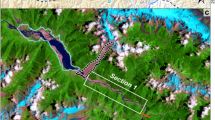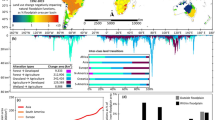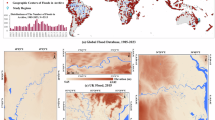Abstract
In 2021, a catastrophic flood occurred in the Melamchi Valley of Nepal, causing widely distributed erosion in Himalayan headwaters and mobilizing a large sediment volume. As the flood progressed downstream, it induced an erosional cascade, producing 100 m deep incisions into high-elevation valley fills, generating new landslides and burying the lower reaches in alluvium. This event demonstrated the destructive impact of cascading processes and their potential for reshaping the landscape.
This is a preview of subscription content, access via your institution
Access options
Access Nature and 54 other Nature Portfolio journals
Get Nature+, our best-value online-access subscription
$32.99 / 30 days
cancel any time
Subscribe to this journal
Receive 12 print issues and online access
$259.00 per year
only $21.58 per issue
Buy this article
- Purchase on SpringerLink
- Instant access to full article PDF
Prices may be subject to local taxes which are calculated during checkout



Similar content being viewed by others
Data availability
Geomorphologic mapping data are available in HydroShare (https://doi.org/10.4211/hs.b6da096000284d5882d13b085b7669ac). Source data are provided with this paper. DSM data are available in OpenTopography (https://doi.org/10.5069/G9R78CFK).
References
Shugar, D. et al. A massive rock and ice avalanche caused the 2021 disaster at Chamoli, Indian Himalaya. Science 373, 300–306 (2021).
Cook, K. L., Andermann, C., Gimbert, F., Adhikari, B. R. & Hovius, N. Glacial lake outburst floods as drivers of fluvial erosion in the Himalaya. Science 362, 53–57 (2018).
Harrison, S. et al. Climate change and the global pattern of moraine-dammed glacial lake outburst floods. Cryosphere 12, 1195–1209 (2018).
Veh, G., Korup, O. & Walz, A. Hazard from Himalayan glacier lake outburst floods. Proc. Natl Acad. Sci. USA 117, 907–912 (2020).
Cenderelli, D. A. & Wohl, E. E. Flow hydraulics and geomorphic effects of glacial‐lake outburst floods in the Mount Everest region, Nepal. Earth Surface. Process. Landf. 28, 385–407 (2003).
Rathburn, S. et al. The fate of sediment, wood, and organic carbon eroded during an extreme flood, Colorado Front Range, USA. Geology 45, 499–502 (2017).
Church, M. & Jakob, M. What is a debris flood? Water Resour. Res. 56, e2020WR027144 (2020).
Roback, K. et al. The size, distribution, and mobility of landslides caused by the 2015 Mw 7.8 Gorkha earthquake, Nepal. Geomorphology 301, 121–138 (2018).
Maharjan, S. B. et al. The Melamchi Flood Disaster: Cascading Hazard and the Need for Multihazard Risk Management (ICIMOD, 2021).
Adhikari, T. R. et al. Evaluation of post extreme floods in high mountain region: a case study of the Melamchi flood 2021 at the Koshi River Basin in Nepal. Nat. Hazards Res. 3, 437–446 (2023).
Takamatsu, M., Karelia, H. D., Lnu, T. O. & Dahal, R. K. Melamchi Flood Disaster in Nepal: Damage and Risk Quantification with Drone Survey, Satellite-Based Land Displacement analysis, and 2D Flood Modeling (World Bank Group, 2022).
Graf, E. L. et al. Geomorphological and hydrological controls on sediment export in earthquake-affected catchments in the Nepal Himalaya. Earth Surf. Dyn. 12, 135–161 (2024).
ADB. Mapping Hazards in Nepal’s Melamchi River: Catchment to Enhance Kathmandu’s Water Security (Asian Development Bank, 2023).
Jones, J. N., Boulton, S. J., Stokes, M., Bennett, G. L. & Whitworth, M. R. 30-year record of Himalaya mass-wasting reveals landscape perturbations by extreme events. Nat. Commun. 12, 6701 (2021).
Medwedeff, W. Interdependencies Between Landslides, Rock Strength, and Landscape Evolution in the Himalaya, Central Nepal. PhD Thesis, Univ. Michigan (2022).
Pandey, V. et al. Multiperspective Field Reconnaissance After the Melamchi Debris Flow of June 15, 2021 in Central Nepal (NEA, 2021).
Dufek, J. & Bergantz, G. Suspended load and bed-load transport of particle-laden gravity currents: the role of particle–bed interaction. Theor. Comput. Fluid Dyn. 21, 119–145 (2007).
Boyer, C., Roy, A. G. & Best, J. L. Dynamics of a river channel confluence with discordant beds: flow turbulence, bed load sediment transport, and bed morphology. J. Geophys. Rese. Earth Surf. https://doi.org/10.1029/2005JF000458 (2006).
Todd, S. P. Stream‐driven, high‐density gravelly traction carpets: possible deposits in the Trabeg Conglomerate Formation, SW Ireland and some theoretical considerations of their origin. Sedimentology 36, 513–530 (1989).
Korup, O. & Tweed, F. Ice, moraine, and landslide dams in mountainous terrain. Quat. Sci. Rev. 26, 3406–3422 (2007).
Schwanghart, W. et al. Repeated catastrophic valley infill following medieval earthquakes in the Nepal Himalaya. Science 351, 147–150 (2016).
Dhital, M. R. in Geology of the Nepal Himalaya (ed. Dhital, M. R.) 153–162 (Springer, 2015).
Pandey, M., Tandukar, R., Avouac, J., Vergne, J. & Heritier, T. Seismotectonics of the Nepal Himalaya from a local seismic network. J. Asian Earth Sci. 17, 703–712 (1999).
Robert, X. et al. Assessing Quaternary reactivation of the Main Central thrust zone (central Nepal Himalaya): new thermochronologic data and numerical modeling. Geology 37, 731–734 (2009).
Herman, F. et al. Exhumation, crustal deformation, and thermal structure of the Nepal Himalaya derived from the inversion of thermochronological and thermobarometric data and modeling of the topography. J. Geophys. Res. Solid Earth https://doi.org/10.1029/2008JB006126 (2010).
Pandey, M., Tandukar, R., Avouac, J., Lave, J. & Massot, J. Interseismic strain accumulation on the Himalayan crustal ramp (Nepal). Geophys. Res. Lett. 22, 751–754 (1995).
Hubbard, J. et al. Structural segmentation controlled the 2015 Mw 7.8 Gorkha earthquake rupture in Nepal. Geology 44, 639–642 (2016).
Bookhagen, B. & Burbank, D. W. Toward a complete Himalayan hydrological budget: spatiotemporal distribution of snowmelt and rainfall and their impact on river discharge. J. Geophys. Res. Earth Surf. https://doi.org/10.1029/2009JF001426 (2010).
Steiner, J. Tipping Bucket: Ganja La 1, 2, 3 (ICIMOD and Utrecht Univ., 2020).
Steiner, J. F. et al. Multi‐year observations of the high mountain water cycle in the Langtang catchment, Central Himalaya. Hydrol. Process. 35, e14189 (2021).
Aryal, A., Maharjan, M., Talchabhadel, R. & Thapa, B. R. Characterizing meteorological droughts in Nepal: a comparative analysis of standardized precipitation index and rainfall anomaly index. Earth 3, 409–432 (2022).
2012–2022 Daily Precipitation at Duwachaur and Sarmathang (DHM, 2022).
Moratto, Z. M., Broxton, M. J., Beyer, R. A., Lundy, M. & Husmann, K. Ames Stereo Pipeline, NASA's Open Source Automated Stereogrammetry Software. 41st Lunar and Planetary Science Conference. LPI Contribution no. 1533, p. 2364 (2010).
Beyer, R. A., Alexandrov, O. & McMichael, S. The Ames Stereo Pipeline: NASA’s open source software for deriving and processing terrain data. Earth and Space Science 5, 537–548 (2018).
Shean, D. E., O. Alexandrov, Z. Moratto, B. E. Smith, I. R. Joughin, C. C. Porter, Morin, P. J. An automated, open-source pipeline for mass production of digital elevation models (DEMs) from very high-resolution commercial stereo satellite imagery. ISPRS J. Photogramm. Remote Sens. 116, 101–117 (2016).
Nuth, C. & Kääb, A. Co-registration and bias corrections of satellite elevation data sets for quantifying glacier thickness change. Cryosphere 5, 271–290 (2011).
Hugonnet, R. et al. Uncertainty analysis of digital elevation models by spatial inference from stable terrain. IEEE J. Sel. Top. Appl. Earth Obs. Remote Sens. 15, 6456–6472 (2022).
Lane, S. N., Westaway, R. M. & Murray Hicks, D. Estimation of erosion and deposition volumes in a large, gravel‐bed, braided river using synoptic remote sensing. Earth Surf. Process. Landf. 28, 249–271 (2003).
Lamb, M. P., Dietrich, W. E. & Venditti, J. G. Is the critical Shields stress for incipient sediment motion dependent on channel‐bed slope? J. Geophys. Res. Earth Surf. https://doi.org/10.1029/2007JF000831 (2008).
Azarafza, M. et al. Discontinuous rock slope stability analysis by limit equilibrium approaches–a review. Int. J. Digital Earth 14, 1918–1941 (2021).
Wyllie, C. and Mah, W. in Rock Slope Engineering (eds Hoek, E. and Bray, J. W.) (Taylor & Francis, 2004).
Medwedeff, W. G., Clark, M. K., Zekkos, D., West, A. J. & Chamlagain, D. Near‐surface geomechanical properties and weathering characteristics across a tectonic and climatic gradient in the Central Nepal Himalaya. J. Geophys. Res. Earth Surf. 127, e2021JF006240 (2022).
Acknowledgements
This work is supported by the US NSF Frontier Research in Earth Sciences programme awards 2021619 to A.J.W., 2020970 to M.K.C. and 2021299 to D.Z. We thank J. Roering, K. Cook, J. Steiner, A. Dehecq and G. Li for helpful discussions, and B. Sitaula and H. Tamang for field assistance. We thank the Department of Mines and Geology (DMG) and the Department of Hydrology and Meteorology, Government of Nepal, for fieldwork permission, guidance and rainfall data collection.
Author information
Authors and Affiliations
Contributions
A.J.W., C.-M.C., M.K.C., D. Z. and D.C. conceived the study. All authors contributed to study design. C.-M.C., A.J.W. and J.H. performed the remote-sensing analyses. C.-M.C., S.B. and A.S. collected the field data. C.-M.C. and A.J.W. interpreted the data and wrote the manuscript with contributions from all co-authors.
Corresponding author
Ethics declarations
Competing interests
The author declares no competing interests.
Peer review
Peer review information
Nature Geoscience thanks Suzanne Anderson, Georgina Bennett and Mikel Calle for their contribution to the peer review of this work. Primary Handling Editor: Tom Richardson, in collaboration with the Nature Geoscience team.
Additional information
Publisher’s note Springer Nature remains neutral with regard to jurisdictional claims in published maps and institutional affiliations.
Extended data
Extended Data Fig. 1 Climatic and geologic context of the Melamchi Valley.
The Melamchi valley features N-S gradients of (a) orographic rainfall (Bookhagen & Burbank28) and (b) exhumation rate (Robert et al.24; Herman et al.25; Medwedeff15). The major faults in the orogenic system include the Main Himalayan Thrust (MHT), Main Frontal Fault (MFT), Main Boundary Thrust (MBT), Main Central Thrust (MCT), and South Tibetan Detachment (STD). (c) Geologic Profile under Kathmandu-Melamchi Valley. Panels adapted with permission from: b, ref. 22, Springer Nature Limited; c, ref. 26, Elsevier.
Extended Data Fig. 2 Geomorphic impacts of the 2021 flood in the Melamchi headwaters.
Massive sediment outputs were observed after the flood, especially in the Pemdang Khola where glacial moraines were cut by up to 40 m. Some 2021 activity was associated with landslides from the 2015 Gorkha earthquake, but most erosion was new. Credit: satellite images, Pléiades © CNES 2021, Distribution AIRBUS DS.
Extended Data Fig. 3 Geomorphic impacts of the 2021 flood around Bremathang.
The top of the large landslide dam was covered by 5–10 m of flood deposits, while its lower, steep part experienced >100 m incision. Credit: satellite images, Pléiades © CNES 2021, Distribution AIRBUS DS.
Extended Data Fig. 4 Observations of the Bremathang Dam incision.
Top: Geometry of the Bremathang natural dam before and after the 2021 and 2023 floods. Topographic and sedimentary evidence suggests that the dam had been stable for a long period before the floods. No active erosion was observed on the dam surface before 2021. Arrows on contour maps from 2023 show new erosional activity since 2021, most occurring in August 2023 (also see Fig. 1). Bottom: The profiles of the sediment deposits behind the dam, exposed by erosion during the 2021 flood, reveal (1) remnants of a carpet of giant boulders that protected the dam and (2) a thick layer (at least 10 m) of fine-grained material (predominantly sand size fraction from field observations) beneath coarser deposits that we attribute to the 2021 flood. Deposit thickness is between 5.074 and 5.29 m indicated from DoD, validated by field measurement (5.181 m) at the star-marked site in May 2024. The origin of the dam is unclear but plausibly related to past glacial advances and mass-wasting processes on surrounding steep slopes.
Extended Data Fig. 5 Geomorphic impacts of the 2021 flood in the middle reaches of Melamchi Khola.
Slope failures and riverbed downcutting occurred due to intensive sediment transport. Credit: satellite images, Pléiades © CNES 2021, Distribution AIRBUS DS.
Extended Data Fig. 6 Slope stability analysis for the toe-cutting scenario at the Melamchi Ghyang Landslide.
We used the limit equilibrium approach (Azarafza et al.40) with the planer sliding model (Wyllie & Mah41) to examine the cause of the Melamchi Ghyang Landslide. We found that the factor of safety (FoS) dropped under 1 after 15–21 m incision, supporting the hypothesis of rapid downcutting at the toe of the hillslope during flooding. Credit: satellite images, Pléiades © CNES 2021, Distribution AIRBUS DS.
Extended Data Fig. 7 Geomorphic impacts of the 2021 flood in the lower reaches of Melamchi Khola.
Massive aggradation (15–23 m) was observed on the riverbed near Kyul. Following change detection indicates rapid evacuation of sediment (1–6 m lowering between Oct 2021 and Dec 2023). Intense lateral erosion and large slope failure at where the river curves near Talamarang. The slope failure extended further upslope during Oct 2021-Dec 2023. Credit: satellite images, Pléiades © CNES 2021, Distribution AIRBUS DS.
Extended Data Fig. 8 Field observations in the middle and lower reaches of the Melamchi Khola.
The DoD results were validated at Sarkathali, the MWSP headwork, and Melamchi Bazaar. Elevation change measurements are consistent between the DoD and in-situ observations. (a-c) Incision of terrace and debris fan deposits around Sarkathali, large riverbank landslides between Sarkathali and the headwork of the Melamchi Water Supply Project (MWSP), and significant aggradation around and below the headwork site. (d-f) Aggradation of 5–10 m around the confluence of the Melamchi Khola and Yangri Khola. Contrast to the upstream parts, post-flood sediment evacuation around and below this area has been significantly contributed by anthropogenic activities, such as gravel mining and river engineering, according to our field observations and interviews.
Supplementary information
Supplementary Table 1
Stereo satellite imagery used in this study.
Supplementary Table 2
Parameters invoked in the NASA Ames Stereo Pipeline algorithm for DSM production.
Supplementary Table 3
Uncertainty analyses of DSM difference and result summary.
Source data
Source Data for Fig. 3
Data of channel elevation, channel width, boulder size measurements, hydraulic reconstruction and flood-level markers.
Rights and permissions
Springer Nature or its licensor (e.g. a society or other partner) holds exclusive rights to this article under a publishing agreement with the author(s) or other rightsholder(s); author self-archiving of the accepted manuscript version of this article is solely governed by the terms of such publishing agreement and applicable law.
About this article
Cite this article
Chen, CM., Hollingsworth, J., Clark, M.K. et al. Erosional cascade during the 2021 Melamchi flood. Nat. Geosci. 18, 32–36 (2025). https://doi.org/10.1038/s41561-024-01596-x
Received:
Accepted:
Published:
Issue date:
DOI: https://doi.org/10.1038/s41561-024-01596-x



